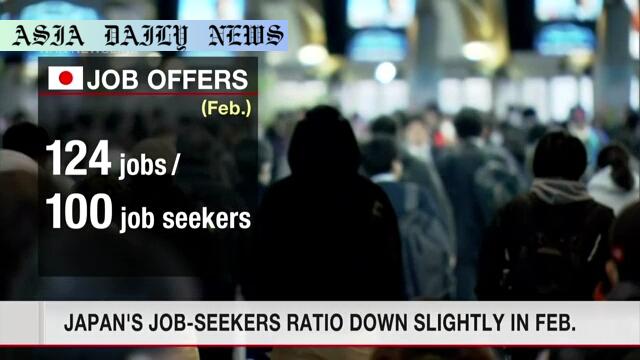Job-seekers ratio: Japan’s job openings to seekers ratio dropped slightly in February due to inflation and cautious business hiring.
Job-seekers ratio decreased slightly in Japan in February.
Ratio dropped to 124 job openings for every 100 applicants nationwide.
New job offers declined in all 11 major industries.
Key industries affected include accommodation, living-related services, and construction.
Inflation and rising costs discouraged businesses from hiring.
Ministry monitoring trends as businesses remain cautious.

Introduction To Japan’s Job Market Challenges
Japan’s job-seekers ratio, a critical determinant of economic health, fell slightly in February 2023—a drop marking the first month-on-month decline since August of the previous year. With inflation driving up prices and utility costs, many businesses remain hesitant to expand their workforce, highlighting the wider economic hurdles the nation continues to face. On average, 124 jobs were available per 100 applicants across the country, reflecting a tightening of opportunities in a labor market traditionally known for its robustness.
Industries Hit Hardest by Decline
A deeper analysis reveals substantial declines in new job offers across all 11 major industries, with certain sectors more affected than others. The accommodation, eating, and drinking services sector faced the steepest drop, plummeting 17.6%. Other sectors did not fare much better; the living-related services and amusement industry witnessed a 10.5% decline, while construction and manufacturing saw drops of 9.1% and 6.5%, respectively. These reductions highlight the mounting unease among industries that traditionally rely on consumer spending or fixed investment, with companies scaling back hiring plans to navigate financial uncertainties driven by inflation.
Economic Impact and Broader Implications
The implications of this decline could be far-reaching. A cautious hiring approach means businesses are likely missing out on opportunities to fill existing workforce shortages, which could slow down productivity and growth. Inflation and soaring utility costs have reportedly exacerbated this issue, making it costlier for companies to onboard additional staff. This trend might also contribute to rising unemployment rates in the short term while prolonging economic challenges in the longer term. As policymakers navigate these evolving concerns, a close watch on labor trends will be essential to designing effective interventions.
Looking Ahead: Ministry’s Focus on Economic Recovery
Japan’s labor ministry has expressed its commitment to monitoring labor market dynamics closely, especially as inflation continues to influence hiring decisions. With key industries like construction and manufacturing still reluctant to expand their workforce, the ministry’s engagement with struggling sectors is critical for preventing further declines. Prioritizing initiatives to address soaring prices, support businesses, and stimulate economic activity will be crucial to ensuring a stable recovery. Policymakers will also need to enact programs that encourage job creation in industries exhibiting persistent hiring demand.
Conclusion
The slight reduction in job availability signifies deeper economic challenges within Japan’s labor market, underscoring the pressing need for targeted measures to address inflation and its far-reaching consequences. By facilitating business support mechanisms and workforce development programs, Japan can better navigate the current labor tightness and build pathways for sustainable economic growth. As always, vigilance and adaptability will be key factors in overcoming this chapter of economic uncertainty.



Commentary
The Complexities of Japan’s Job Market Shift
The recent dip in Japan’s job-seekers ratio could initially appear marginal, but it bears significant implications for the broader economy. Understanding this decline requires us to delve deeper into the intertwined challenges of inflation, hiring trends, and industry-specific struggles. Businesses, when faced with increasing costs, naturally adopt cautious strategies to safeguard their bottom line, and this pattern often translates into reduced hiring activity. What’s concerning is that inflation impacts not just operational costs but also consumer spending behavior, creating a chain reaction of reduced demand across sectors.
Sectors in the Spotlight
The sharp drop in job offers within the accommodation, eating and drinking services sector could be an indicator of weakening confidence in consumer-based industries. These sectors are often the first to experience fluctuations during times of economic uncertainty, as discretionary spending habits change. Similarly, the sluggishness in construction and manufacturing reveals a more systemic issue: businesses’ hesitation to invest and expand during uncertain times. As these industries collectively employ large portions of the workforce, their reluctance to hire adds strain to an already complex labor market.
Policy Implications
This development raises questions about government and institutional responses. While the labor ministry’s intent to monitor trends is commendable, it is clear that more proactive steps may need to be taken. Encouraging businesses to hire, perhaps through subsidies or tax incentives, could provide a cushion for industries feeling the pinch of inflation. Furthermore, targeted skills-building initiatives could help align the labor force with the evolving demands of employers, ensuring a mutual benefit for workers and industries alike.
Conclusion
As we examine the complexities surrounding Japan’s job-seekers ratio, it becomes evident that this issue is not merely about numbers but about the broader economic dynamics at play. Policymakers must remain agile, anticipating future shifts and implementing timely interventions to navigate the challenges. With the right strategy, Japan can turn this moment of uncertainty into an opportunity for growth and innovation.